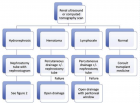Abstract
Case Report
Recurrent Cardiac Events Driven by Prothrombotic Burden in a Patient Undergoing Lipoprotein Apheresis for High Lp(a) Levels
Gabriele Cioni*, Rossella Marcucci, Rosanna Abbate and Giovanna D’Alessandri
Published: 15 March, 2017 | Volume 1 - Issue 1 | Pages: 001-005
Introduction: Lipoprotein (a) [Lp(a)] is a marker for cardiovascular disease, involved in pathogenesis and progression of atherosclerosis. In selected high-risk patients, lipoprotein-apheresis could optimize secondary prevention and improve prognosis.
Aim: We presented the case of a 49-year-old man with high lipoprotein (a) levels and recurrent cardiac adverse events, despite maximal pharmacological therapy.
Case report: Four years before the admission at our Centre, he presented an anterior STEMI, treated with angioplasty and implantation of a drug eluting stent on left anterior descending artery, at the age of 47 years, in September 2012; one month later, the patients presented a new episode of angina, and exams showed a critical stenosis in the right coronary artery, treated by angioplasty and implantation of drug eluting stent. Because of high Lp(a) plasma levels, patient was subsequently on regularly 7-10 day lipoprotein apheresis.
Results and discussion: A thrombophilic screening was performed, showing the simultaneous presence of heterozygous V Leiden mutation and prothrombin G20210A mutation. He referred to our Centre in order to optimize therapy; we performed an endothelial function assessment showing a severe dysfunctional pattern.
Because of these findings, we prescribed dual antiplatelet therapy, and we added omega-3 fatty acids and association with nicotinic acid/laropiprant. According with current guidelines, considering the high risk of bleeding, we preferred not to administer anticoagulant therapy. At 6-month and 1-year follow up the patient continued lipoprotein apheresis and was asymptomatic for other cardiovascular events.
Conclusions: The assessment for the eventual presence of thrombophilia might become a useful tool in clinical practice for high-risk selected patients.
Read Full Article HTML DOI: 10.29328/journal.hcem.1001001 Cite this Article Read Full Article PDF
Keywords:
Lipoprotein apheresis; Thrombophilia lipoprotein; (a)Endothelial dysfunction peripheral arterial tonometry TEXT
References
- Anuurad E, Boffa MB, Koschinsky ML, Berglund L. Lipoprotein(a): a unique risk factor for cardiovascular disease. Clin Lab Med. 2006; 26: 751-772. Ref.: https://goo.gl/Q8XV9Z
- Boffa MB, Marcovina SM, Koschinsky ML. Lipoprotein(a) as a risk factor for atherosclerosis and thrombosis: mechanistic insights from animal models. Clin Biochem. 2004; 37: 333-343. Ref.: https://goo.gl/Dm0jv3
- Danesh J, Erqou S. Risk factors: Lipoprotein(a) and coronary disease-moving closer to causality. Nat Rev Cardiol. 2009; 6: 565-567. Ref.: https://goo.gl/fYG7J0
- Emerging Risk Factors Collaboration, Erqou S, Kaptoge S, Perry PL, Di Angelantonio E, et al. Lipoprotein(a) concentration and the risk of coronary heart disease, stroke, and nonvascular mortality. JAMA. 2009; 302: 412-423. Ref.: https://goo.gl/6XVYRI
- Sofi F, Marcucci R, Abbate R, Gensini GF, Prisco D. Lipoprotein (a) and venous thromboembolism in adults: a meta-analysis. Am J Med. 2007; 120: 728-733. Ref.: https://goo.gl/6sJAkk
- Klingel R, Heibges A, Fassbender C. Lipoprotein apheresis results in plaque stabilization and prevention of cardiovascular events: comments on the prospective Pro(a)LiFe study. Clin Res Cardiol Suppl. 2015; 10: 46-50. Ref.: https://goo.gl/pJcLcy
- Archontakis S, Pottle A, Hakim N, Ilsley C, Barbir M. LDL-apheresis: indications and clinical experience in a tertiary cardiac centre. Int J Clin Pract. 2007; 61: 1834-1842. Ref.: https://goo.gl/w1IKOa
- European Stroke Organisation, Tendera M, Aboyans V, Bartelink ML, Baumgartner I, et al. ESC Guidelines on the diagnosis and treatment of peripheral artery diseases: Document covering atherosclerotic disease of extracranial carotid and vertebral, mesenteric, renal, upper and lower extremity arteries: the Task Force on the Diagnosis and Treatment of Peripheral Artery Diseases of the European Society of Cardiology (ESC). Eur Heart J. 2011; 32: 2851-2906. Ref.: https://goo.gl/8FSRsz
- Schwartz J, Padmanabhan A, Aqui N, Balogun RA, Connelly-Smith L, et al. Guidelines on the Use of Therapeutic Apheresis in Clinical Practice-EvidenceBased Approach from the Writing Committee of the American Society for Apheresis: The Seventh Special Issue. J Clin Apher.2016; 31: 149-162. Ref.: https://goo.gl/L5bl54
- The HPS-THRIVE Collaborative Group, Landray MJ, Haynes R, Hopewell JC, Parish S. Effects of Extended-Release Niacin with Laropiprant in High-Risk Patients. N Engl J Med. 2014; 371: 203-212. Ref.: https://goo.gl/p8fvjj
- Lim MY, Deal AM, Kim S, Musty MD, Conard J, et al. Thrombophilic Risk of Individuals with Rare Compound Factor V Leiden and Prothrombin G20210A Polymorphisms: An International Case-Series of 100 Individuals. Eur J Haematol. 2016; 97: 353-360. Ref.: https://goo.gl/zGBkQa
- Baglin T Gray E, Greaves M, Hunt BJ, Keeling D, Machin S, et al. Clinical guidelines for testing for heritable thrombophilia. Br J Haematol. 2010; 149: 209-220. Ref.: https://goo.gl/4DkCFV
- Bates SM, Greer IA, Middeldorp S, Veenstra DL, Prabulos AM, et al. VTE, thrombophilia, antithrombotic therapy, and pregnancy: Antithrombotic Therapy and Prevention of Thrombosis, 9th ed. American College of Chest Physicians Evidence-Based Clinical Practice Guidelines. Chest. 2012; 141: 691S-736S. Ref.: https://goo.gl/JgkxfD
- Brouwer JL, Lijfering WM, Ten Kate MK, Kluin-Nelemans HC, Veeger NJ, et al. High long-term absolute risk of recurrent venous thromboembolism in patients with hereditary deficiencies of protein S, protein C or antithrombin. Thromb Haemost. 2009; 101: 93-99. Ref.: https://goo.gl/2zTp7f
- Puricel S, Lehner C, Oberhänsli M, Rutz T, Togni M, et al. Acute coronary syndrome in patients younger than 30 years--aetiologies, baseline characteristics and long-term clinical outcome. Swiss Med Wkly. 2013; 143: 13816. Ref.: https://goo.gl/i7lBzs
- Heffernan KS, Karas RH, Patvardhan EA, Jafri H, Kuvin JT. Peripheral arterial tonometry for risk stratification in men with coronary artery disease. Clin Cardiol. 2010; 33: 94-98. Ref.: https://goo.gl/6meeF8
- Poredos P, Jezovnik MK. Testing endothelial function and its clinical relevance. J Atheroscler Thromb. 2013; 20: 1-8. Ref.: https://goo.gl/cjjnI6
- Cai A, Li L, Zhang Y, Mo Y, Mai W, et al. Lipoprotein(a): a promising marker for residual cardiovascular risk assessment. Dis Markers. 2013; 35: 551-559. Ref.: https://goo.gl/zejdSa
- Roeseler E, Julius U, Heigl F, Spitthoever R, Heutling D, et al. Lipoprotein Apheresis for Lipoprotein(a)-Associated Cardiovascular Disease: Prospective 5 Years of Follow-Up and Apo(a) Characterization. Arterioscler Thromb Vasc Biol. 2016; 36: 2019-2027. Ref.: https://goo.gl/gDVhwh
- Klingel R, Heibges A, Fassbender C, Pro(a)LiFe-Study Group. Prevention of cardiovascular complications in patients with Lp(a)-hyperlipoproteinemia and progressive cardiovascular disease by long-term lipoprotein apheresis according to German national guidelines. Clin Res Cardiol Suppl. 2017. Ref.: https://goo.gl/MNo4h3
- Leebmann J, Roeseler E, Julius U, Heigl F, Spitthoever R, et al. Lipoprotein apheresis in patients with maximally tolerated lipid-lowering therapy, Lipoprotein(a)-hyperlipoproteinemia, and progressive cardiovascular disease: prospective observational multicenter study. Circulation. 2013; 128: 2567-2576. Ref.: https://goo.gl/xC7jNI
- Frolow M, Drozdz A, Kowalewska A, Nizankowski R, Chlopicki S. Comprehensive assessment of vascular health in patients; towards endothelium-guided therapy. Pharmacol Rep. 2015; 67: 786-792. Ref.: https://goo.gl/q5ZUpl
Similar Articles
-
Recurrent Cardiac Events Driven by Prothrombotic Burden in a Patient Undergoing Lipoprotein Apheresis for High Lp(a) LevelsGabriele Cioni*,Rossella Marcucci,Rosanna Abbate,Giovanna D’Alessandri. Recurrent Cardiac Events Driven by Prothrombotic Burden in a Patient Undergoing Lipoprotein Apheresis for High Lp(a) Levels. . 2017 doi: 10.29328/journal.hcem.1001001; 1: 001-005
Recently Viewed
-
Exploring the Potential of Medicinal Plants in Bone Marrow Regeneration and Hematopoietic Stem Cell TherapyUgwu Okechukwu Paul-Chima*,Alum Esther Ugo. Exploring the Potential of Medicinal Plants in Bone Marrow Regeneration and Hematopoietic Stem Cell Therapy. Int J Bone Marrow Res. 2025: doi: 10.29328/journal.ijbmr.1001019; 8: 001-005
-
Penile Fracture: The “Cracking” Sound and Intra-operative Tunica Albuginea RepairAyoub Mamad*,Mohammed Amine Bibat,Mohammed Amine Elafari,Youssef Maachi,Amine Slaoui,Tarik Karmouni,Abdelatif Koutani,Khalid Elkhader. Penile Fracture: The “Cracking” Sound and Intra-operative Tunica Albuginea Repair. J Clin Med Exp Images. 2026: doi: 10.29328/journal.jcmei.1001038; 10: 001-002
-
New pharmacological strategies in some metabolic endocrine disorder under a toxicological approachLuisetto M*,Ghulam Rasool Mashori,Cabianca luca. New pharmacological strategies in some metabolic endocrine disorder under a toxicological approach. Ann Clin Endocrinol Metabol. 2018: doi: 10.29328/journal.acem.1001006; 2: 015-021
-
Long monitoring of Birds of Elssuki Area. Sinnar State, SudanMohamed Elmekki Ali Elbadawi Hussien*. Long monitoring of Birds of Elssuki Area. Sinnar State, Sudan. Insights Vet Sci. 2024: doi: 10.29328/journal.ivs.1001040; 8: 001-011
-
Complications of External Otitis in HorsesSchusser GF*, Kuhlmann CHR, Scheidemann W. Complications of External Otitis in Horses. Insights Vet Sci. 2024: doi: 10.29328/journal.ivs.1001041; 8: 012-014
Most Viewed
-
Impact of Latex Sensitization on Asthma and Rhinitis Progression: A Study at Abidjan-Cocody University Hospital - Côte d’Ivoire (Progression of Asthma and Rhinitis related to Latex Sensitization)Dasse Sery Romuald*, KL Siransy, N Koffi, RO Yeboah, EK Nguessan, HA Adou, VP Goran-Kouacou, AU Assi, JY Seri, S Moussa, D Oura, CL Memel, H Koya, E Atoukoula. Impact of Latex Sensitization on Asthma and Rhinitis Progression: A Study at Abidjan-Cocody University Hospital - Côte d’Ivoire (Progression of Asthma and Rhinitis related to Latex Sensitization). Arch Asthma Allergy Immunol. 2024 doi: 10.29328/journal.aaai.1001035; 8: 007-012
-
Causal Link between Human Blood Metabolites and Asthma: An Investigation Using Mendelian RandomizationYong-Qing Zhu, Xiao-Yan Meng, Jing-Hua Yang*. Causal Link between Human Blood Metabolites and Asthma: An Investigation Using Mendelian Randomization. Arch Asthma Allergy Immunol. 2023 doi: 10.29328/journal.aaai.1001032; 7: 012-022
-
An algorithm to safely manage oral food challenge in an office-based setting for children with multiple food allergiesNathalie Cottel,Aïcha Dieme,Véronique Orcel,Yannick Chantran,Mélisande Bourgoin-Heck,Jocelyne Just. An algorithm to safely manage oral food challenge in an office-based setting for children with multiple food allergies. Arch Asthma Allergy Immunol. 2021 doi: 10.29328/journal.aaai.1001027; 5: 030-037
-
Snow white: an allergic girl?Oreste Vittore Brenna*. Snow white: an allergic girl?. Arch Asthma Allergy Immunol. 2022 doi: 10.29328/journal.aaai.1001029; 6: 001-002
-
Cytokine intoxication as a model of cell apoptosis and predict of schizophrenia - like affective disordersElena Viktorovna Drozdova*. Cytokine intoxication as a model of cell apoptosis and predict of schizophrenia - like affective disorders. Arch Asthma Allergy Immunol. 2021 doi: 10.29328/journal.aaai.1001028; 5: 038-040

If you are already a member of our network and need to keep track of any developments regarding a question you have already submitted, click "take me to my Query."















































































































































